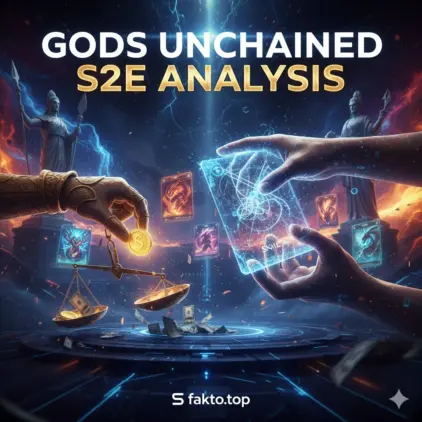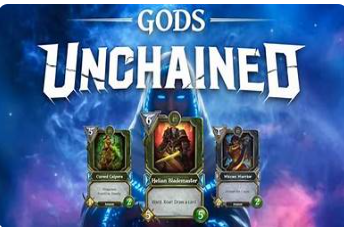Gods Unchained: Why Skill, Not Wallet, Defines the Ultimate Web3 TCG in 2025
Forget the usual “play-to-earn” hype—most NFT games are flashy promises with little substance. So why is the Gods Unchained NFT card game different in 2025? Is it just another crypto cash grab, or does it actually reward skill, strategy, and persistence? The short answer: it’s one of the rare NFT games where your brain matters more than your wallet.
Unlike the majority of P2E titles, Gods Unchained has survived the crypto winter, maintained a healthy NFT economy, and steadily grown its player base. With over 13 million NFTs minted and more than $25M in card trades, it’s clear that players aren’t just speculating—they’re actively engaging in a skill-based NFT ecosystem. And yes, you can start for free. That alone kills half the “pay-to-win” excuses.
But let’s not kid ourselves: success isn’t guaranteed. Most players will earn modestly at first, grinding ranked matches for Flux and slowly upgrading cards into tradeable NFTs. Yet, this grind is where the game proves its core philosophy: skill compounds value over time. A newbie might ask, “Can I really earn without buying top-tier cards?” — and the answer is yes, though patience and strategy are key.

Consider the meta: GU’s Mana Lock system prevents instant domination by high-cost cards, forcing thoughtful plays rather than wallet-driven wins. Each god’s unique powers also ensure no single deck monopolizes the top ranks. This is why the difference between a casual flipper of $GODS tokens and a top-tier weekend competitor is not the ETH spent but the hours invested in mastering tactics.
And here’s the kicker—while many P2E guides focus on flashy tokenomics or short-term flipping, GU’s economy has real teeth. The $GODS token, currently trading around $0.09–$0.11, is more than a reward—it’s a governance tool, with a planned DAO rollout in 2026 that aims to give players influence over card balance and game updates. That’s a level of player control few NFT games even attempt.

So, is Gods Unchained just hype, or the blueprint for Web3 TCGs? In 2025, it’s both a proving ground for serious gamers and a test case for sustainable crypto gaming economics. Stick around—because understanding its S2E (Skill-to-Earn) model is where the real story begins.
The Skill-to-Earn (S2E) Model: GU vs. Pay-to-Win
So, how does Gods Unchained actually reward skill over spending? And why does this matter in 2025, when so many NFT games lean heavily on “buy your way to the top”? The answer lies in its S2E model—a system designed to let strategy, not wallet size, determine success.
The Mana Lock and God Power Balancing
One of the game’s core innovations is the Mana Lock system. Ever wondered why you can’t just drop a $76,000 card and instantly win? That’s the point. Mana Lock forces players to plan turns ahead, ensuring that high-cost cards require timing and tactical foresight. Combined with diverse God Powers, it guarantees that all six gods remain viable in competitive play. No deck is a guaranteed winner—every match is a mental chessboard.
Players often ask, “Does this really level the playing field?” Honestly, yes—but only if you invest the time to understand the meta. A casual player might flounder at first, but a dedicated strategist can consistently outplay opponents who rely solely on expensive cards.
The “Skill Cliff”: What Separates the Flipper from the Pro
Now let’s talk about the Skill Cliff. This is the invisible gap between someone who passively earns $GODS by playing a few matches a week and a pro who consistently wins high-tier weekend events. It’s not just about knowing the rules—it’s predicting your opponent’s plays, mastering god powers, and building adaptable decks. The casual flipper might earn a few hundred dollars a month, while a top competitor could net thousands in token rewards and rare card flips. Big difference, right?
And here’s a reality check: many guides gloss over this. They focus on quick earnings or rare card speculation. But GU’s real value is in its long-term skill compounding. Ask yourself: Do I want short-term hype or sustainable competitive advantage? For those serious about the game, the answer is obvious—the meta rewards those who think, adapt, and commit.
Deconstructing the Gods Unchained Economy: A Financial Model for Players
So, how does the GU economy really work? Can you earn without sinking a fortune into rare cards? Let’s break it down using October 2025 data. The game’s financial design is not just clever—it’s built to reward time, strategy, and engagement over pure spending.
The Cost of Ownership: Analyzing Flux and The Forge
Winning ranked matches earns Flux, a resource you use to upgrade cards into fully tradable NFTs via The Forge. Here’s the kicker: minting is gas-free thanks to Immutable X. That’s huge. While L1 blockchain games punish you with high transaction fees, GU lets players focus on strategy, not spending hundreds on minting. It’s a real economic advantage, and it scales with skill.
Players often ask, “Do I need to spend to get valuable cards?” Not really. Sure, flipping rare NFTs can be lucrative, but consistent skillful play generates steady $GODS income without huge upfront investment. That’s the beauty of the S2E model.
The $GODS Token Utility: Beyond Simple Rewards
$GODS isn’t just a reward token—it’s a governance asset. Around 34% of token distribution goes to P2E activities, with the current price range between $0.09–$0.11. Players can stake $GODS, participate in the upcoming DAO (2026 outlook), and influence card balance or game updates. In short, holding $GODS means you’re not just earning—you’re shaping the game itself.
Here’s a natural question: Is the token stable enough to matter? Compared to inflationary P2E competitors, GU’s allocation and L2 design give $GODS relative stability. It’s not a get-rich-quick scheme—it’s a strategic asset in a skill-driven ecosystem.
Case Study: Flipping vs. Competing (The $76,000 Card)
Remember that legendary card sold for $76,000? That’s the outlier, a flashy headline. Most players earn modestly but consistently, turning small investments of time into reliable rewards. Flipping a rare card is exciting, but mastering the meta and earning via ranked play builds a sustainable, long-term strategy.
Ask yourself: Do I chase the headline, or do I play smart? The answer defines whether you’re just gambling or actually benefiting from GU’s financial and skill-based design.
The Road to Mass Adoption: Mobile, Staking, and the 2026 Catalyst
So, what will push Gods Unchained from a dedicated PC niche to a mass-market phenomenon in 2026? The answer is a mix of accessibility, governance, and economic incentives. Let’s break it down.
The Mobile Gambit (Q4 2025/2026): The Final Barrier to Millions
The full mobile release is a game-changer. Non-PC gamers and crypto newcomers have been locked out so far—but soon, iOS and Android players will join the ecosystem with wallet integration. This isn’t just convenience; it’s a major growth driver. GU will finally reach casual players who never thought about blockchain.
Here’s a question: Will mobile dilute the competitive meta? Possibly, but developers are implementing AI-assisted matchmaking to ensure skill still matters. The meta will evolve, not collapse.
Decentralization & Longevity: The DAO & Staking Integration
The upcoming DAO gives players control over card balancing and game decisions. Combined with staking of $GODS tokens, it creates a feedback loop that incentivizes long-term engagement rather than quick flipping. This is where GU’s model truly diverges from other P2E titles.
Analytical comparison: why GU’s system beats typical NFT games:
| Feature | Gods Unchained | Typical NFT P2E |
|---|---|---|
| Entry Cost | Free, starter decks included | Often pay-to-start, premium NFTs needed |
| Skill vs Wallet | Skill determines outcomes; Mana Lock & God Powers | High spending often overrides skill |
| Token Utility | $GODS for governance, staking, and play | Mostly cosmetic or simple reward tokens |
| Economic Stability | L2 via Immutable X, limited inflation, data-backed | High volatility, weak tokenomics |
| Community Control | DAO governance planned 2026 | Rarely involved in decision-making |
Why GU Stands Out for 2026
Ask yourself: Do I want a game that evolves with its players or one that dies after hype fades? With mobile expansion, staking, and DAO governance, GU positions itself as a long-term ecosystem. Players aren’t just flipping cards—they’re investing time, strategy, and influence.
For casual earners, the system means sustainable $GODS income. For competitive players, it ensures a dynamic meta. And for speculators, DAO participation and token utility provide a level of control and transparency almost unheard of in NFT gaming.
In short, 2026 isn’t just another year for GU—it’s the moment it scales beyond the early adopters, proving that Web3 games can be fun, strategic, and financially meaningful all at once.
Final Thoughts: Play, Earn, Own
So, who should dive into Gods Unchained in 2025–2026? Competitive gamers who value strategy over spending, cautious crypto enthusiasts seeking sustainable token utility, and anyone curious about skill-based blockchain gaming. If you’re chasing quick flips or hoping to get rich overnight, this probably isn’t your playground. But if you’re ready to invest time, learn the meta, and participate in an evolving ecosystem, GU delivers real value.
Why Skill Beats Wallets and L2 Matters
- Skill > Wallet: Mana Lock, God Powers, and adaptable decks ensure that mastery, not money, drives success.
- L2 > L1: Immutable X provides gas-free minting, cheaper trades, and better scalability compared to traditional Ethereum layer 1 games.
- DAO Integration: 2026 governance empowers players, making strategy and engagement more meaningful than speculation alone.
In essence, GU is more than an NFT card game. It’s a blueprint for sustainable Web3 TCGs: a system where effort, strategy, and participation create tangible rewards and influence. Mobile expansion, staking, and DAO governance will only enhance this model, turning casual players into active community stakeholders and long-term earners.
Disclaimer / No Liability
All content on this website is provided for informational purposes only and does not constitute financial, investment, tax, or legal advice. We are not financial advisors and assume no responsibility for any decisions you make.
Cryptocurrencies are highly volatile and risky. You may lose all invested capital. Always do your own research (DYOR) and consult qualified professionals before making any financial or legal decisions.
We make no guarantees regarding the accuracy, completeness, or reliability of the information provided. References to third-party services or projects do not imply endorsement. By using this site, you agree that all actions are at your own risk and release the site owners and authors from any liability.

